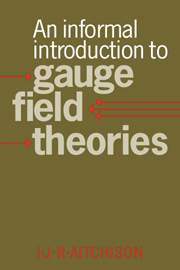Book contents
- Frontmatter
- Contents
- Preface
- Preface to the Paperback Edition
- 1 Introduction and motivations
- 2 Symmetries in quantum field theory: I Manifest
- 3 Gauge fields and the gauge principle
- 4 Quantisation of vector fields: I Massless
- 5 Quantisation of vector fields: II Massive
- 6 Symmetry in quantum field theory: II Hidden
- 7 Theory of weak and electromagnetic interactions
- 8 Renormalisation matters
- References
- Index
4 - Quantisation of vector fields: I Massless
Published online by Cambridge University Press: 20 January 2010
- Frontmatter
- Contents
- Preface
- Preface to the Paperback Edition
- 1 Introduction and motivations
- 2 Symmetries in quantum field theory: I Manifest
- 3 Gauge fields and the gauge principle
- 4 Quantisation of vector fields: I Massless
- 5 Quantisation of vector fields: II Massive
- 6 Symmetry in quantum field theory: II Hidden
- 7 Theory of weak and electromagnetic interactions
- 8 Renormalisation matters
- References
- Index
Summary
It is abundantly clear, at this stage, that we must understand how to quantise massless vector fields, since they play such a fundamental role in the ‘gauge principle’ approach to dynamics. Unfortunately, there is no escaping the fact that this is a difficult and technical matter. Indeed, the derivation of the full Feynman rules for non-Abelian gauge theories was for many years an outstanding problem.
In all gauge theories, a major difficulty arises simply as a consequence of the fact that gauge fields are not uniquely specified by the equations of motion (and given initial conditions), but can always be subjected to a gauge transformation without affecting physical observables. In fact, the vector field Aμ(x) – to take the specific U(1) case – does not really have four independent components. From classical electromagnetic theory, we know perfectly well that the free electromagnetic field has only two independent components (polarisations), not the four corresponding to all of the A0 and A in Aμ. The number of components can be reduced by imposing suitable conditions on Aμ – but then we are involved with the problem of field quantisation subject to constraints. Even the classical Hamiltonian dynamics of such field systems is awkward; what is more, in the quantum case, as we shall see, such constraints cannot be imposed as operator conditions at all. There are also further difficulties.
Information
- Type
- Chapter
- Information
- An Informal Introduction to Gauge Field Theories , pp. 39 - 57Publisher: Cambridge University PressPrint publication year: 1982
